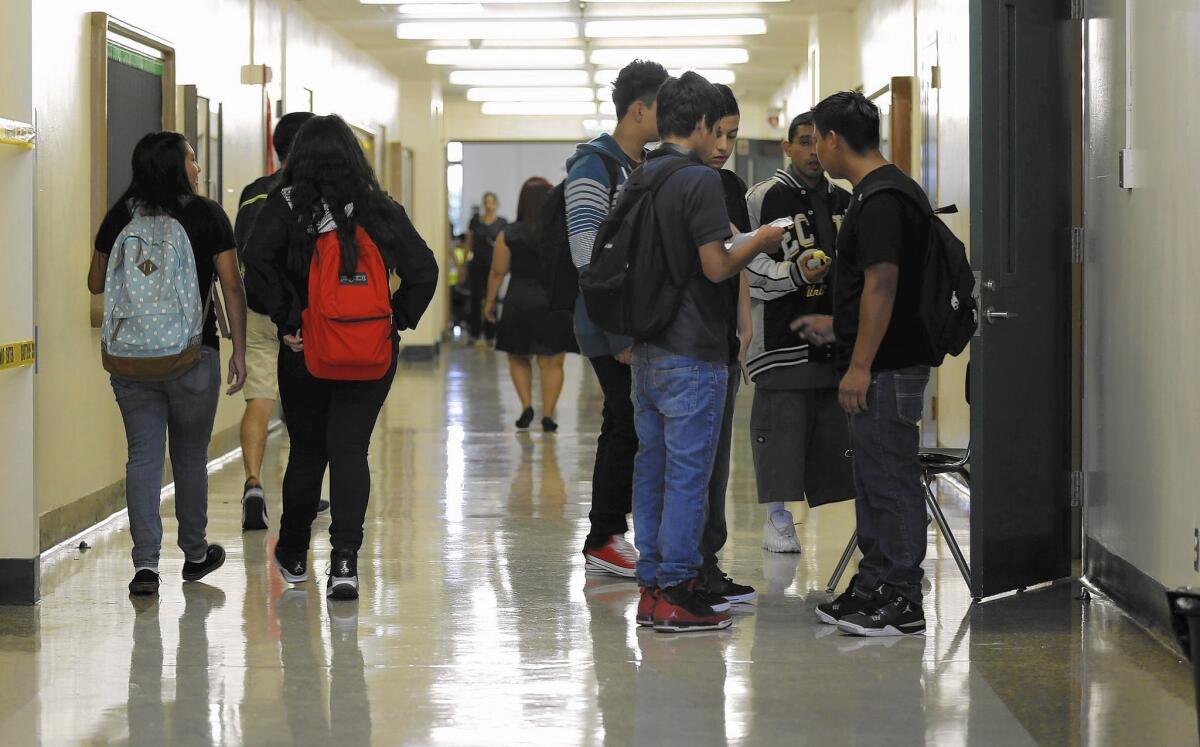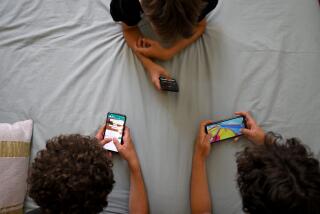How other teachers might have handled the texting South Carolina teen

Before teachers even open a textbook, the subject of classroom rules is typically the first lesson of the school year. Maintaining classroom control and a modicum of discipline is a priority for quality instruction.
But the way instructors deal with defiant students can have long-lasting repercussions. If teachers can’t manage their students, especially in the fall, they risk creating an unruly environment that sets the tone for the rest of the year. If they drop everything to deal with one disruptive student, the entire classroom suffers. If they confront a student and the encounter turns physical or violent, or if they are accused of inappropriate conduct, they can face lengthy investigations that can potentially end their careers.
The Times’ new education initiative to inform parents, educators and students across California >>
After a student refused to leave class after having used her cellphone Monday, her math teacher at Spring Valley High School in Columbia, S.C., called a vice principal, who also asked the girl to leave the class. When she refused, the administrator called Senior Deputy Ben Fields to remove the girl from the classroom. She again refused, officials said.
Fields yanked her from her seat, flipping the desk over, and then threw her across the floor — actions caught on cellphone video. He was fired Tuesday for inappropriate use of force in a case that has stirred national debate on classroom discipline.
The South Carolina episode has teachers in Los Angeles reflecting on their own classroom discipline encounters. Here are three voices:
Kent Peterson resorted to comedy to defuse a bad situation.
Peterson, an eight-year elementary school teacher, made it a point not to raise his voice at students. But one fifth-grader at Hancock Park Elementary tried Peterson’s patience by standing on his chair and yelling when he got frustrated and needed attention. After one episode, “my blood pressure just started to rise, and that’s never a good situation for anyone,” Peterson said.
Frustrated, Peterson thought back to his training in improvisational comedy, and got up on his chair as well. Then he asked his students if anyone else wanted to stand on their chair. The class started to giggle. The defiant boy pouted, but eventually sat down and began to pay attention.
“The scene wasn’t going well, and when that happens you throw a left turn in to liven it up,” he said.
Peterson, who taught in Los Angeles Unified School District from 2002 to 2010, began letting his students occasionally stand on their chairs to discuss their feelings and issues. Now a staff member at USC Rossier School of Education, he said he only called school security to his classroom twice during his teaching career.
When faced with disruptions or students on cellphones, Peterson said he would try to “maintain a level of professionalism and be calm and direct.” Instead of calling in administrators, he would tell students several times that they were expected to put away their phones. He would then leave the student and check in after five minutes.
“I’d ask them if they were ready to have a conversation with me,” Peterson said. “It would be quick and dirty; I wouldn’t neglect my entire class for the individual. But I was trying to show them that I cared more about them than the perceived disrespect.”
Sherlett Hendy Newbill makes clear cellphone rules, but still collects up to 20 a week.
At the beginning of the school year, Dorsey High School physical education teacher Sherlett Hendy Newbill carefully goes over cellphone rules with students so they know the consequences. Students can use cellphones only for assignments, usually about 10% of class time.
Despite a first-time warning, Newbill collects 10 to 20 cellphones a week early in the semester.
“Typically, I walk over and put my hand out, and they give it to me,” said Newbill, who has taught for 19 years.
When students refuse, Newbill calls security. If a student becomes belligerent, she waits for help from an unarmed campus aide and resumes the class.
Newbill said she generally does not physically intervene during student fights. She prefers to wait for another adult to arrive before stepping in so one person can focus on each student. But if immediate safety is an issue, Newbill said, she will act alone.
One time, a parent accused her of handling a girl too forcefully, Newbill said. “I said I treated her as if she was my own child. I wanted to make sure she was safe and the other lady was safe,” she recalled.
“I was really appalled by what I saw,” Newbill said of the video from the South Carolina school. “I couldn’t believe that was happening.”
Joshua Pechthalt watched South Carolina and considered how he would have handled the situation.
The president of the California Federation of Teachers said he avoided calling security into his classroom when he taught at Manual Arts High School for nearly 20 years.
Sometimes Pechthalt would put a problem student in another classroom temporarily where they could sit in the back quietly. “If you keep them in class, you have 35 other kids looking at you wondering what’s going on,” he said.
Pechthalt said that after viewing the video, he wondered how he would’ve approached the girl. “There was so much defiance there,” he said. “It seemed like there was something deep happening.”
Like others interviewed, Pechthalt said disruptive behavior was often a sign of problems at home. Instead of confronting students in the classroom, Pechthalt said, he would try to speak with them out of class or steer them to one of the school’s mental health professionals.
“Kids are very closed; they’re not going to tell you that their parents had a big fight or their cousin was shot at first,” he said. “I was lucky that I had a lot of resources. I’m not sure many schools have them anymore.”
Because there are fewer psychologists or aides on campuses now, Pechthalt said, some teachers will keep a disruptive student in the class if the defiant student is not preventing others from learning. This option can be a better alternative than spending valuable classroom time to track down other school employees to mete out discipline, he said.
“I don’t think that works well,” he said. Calling in police or security was a last resort, Pechthalt said. “That almost always makes things worse in the long run.”
ALSO
Student slams principal to floor during cafeteria melee caught on video
The scramble to get consumers to buy the right health coverage through Obamacare
These water districts are way short of their conservation targets
More to Read
Start your day right
Sign up for Essential California for news, features and recommendations from the L.A. Times and beyond in your inbox six days a week.
You may occasionally receive promotional content from the Los Angeles Times.








